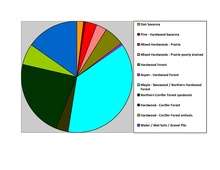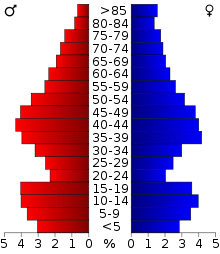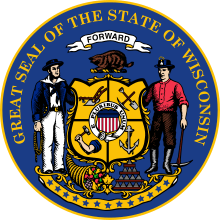Polk County, Wisconsin
Polk County is a county in the U.S. state of Wisconsin. As of the 2010 census, the population was 44,205.[2] Its county seat is Balsam Lake.[3] The county was created in 1853.[4]
Polk County | |
|---|---|
 Polk County Highway Department in Balsam Lake | |
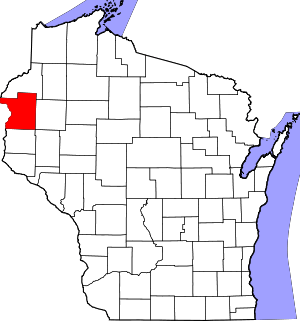 Location within the U.S. state of Wisconsin | |
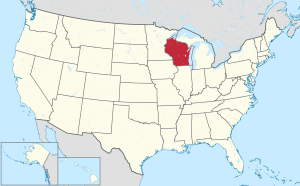 Wisconsin's location within the U.S. | |
| Coordinates: 45°28′N 92°26′W | |
| Country | |
| State | |
| Founded | 1853 |
| Named for | James K. Polk[1] |
| Seat | Balsam Lake |
| Largest city | Amery |
| Area | |
| • Total | 956 sq mi (2,480 km2) |
| • Land | 914 sq mi (2,370 km2) |
| • Water | 42 sq mi (110 km2) 4.4%% |
| Population (2010) | |
| • Total | 44,205 |
| • Estimate (2019) | 43,783 |
| • Density | 46/sq mi (18/km2) |
| Time zone | UTC−6 (Central) |
| • Summer (DST) | UTC−5 (CDT) |
| Congressional district | 7th |
| Website | www |
Geography
According to the U.S. Census Bureau, the county has a total area of 956 square miles (2,480 km2), of which 914 square miles (2,370 km2) is land and 42 square miles (110 km2) (4.4%) is water.[6]
Adjacent counties
- Burnett County - north
- Barron County - east
- Dunn County - southeast
- St. Croix County - south
- Washington County, Minnesota - southwest
- Chisago County, Minnesota - west
Major highways
|
|
Airports
- Amery Municipal Airport (KAHH) serves the county and surrounding communities.
- L.O. Simenstad Municipal Airport (KOEO).
National protected area
Demographics
| Historical population | |||
|---|---|---|---|
| Census | Pop. | %± | |
| 1860 | 1,400 | — | |
| 1870 | 3,422 | 144.4% | |
| 1880 | 10,018 | 192.8% | |
| 1890 | 12,968 | 29.4% | |
| 1900 | 17,801 | 37.3% | |
| 1910 | 21,367 | 20.0% | |
| 1920 | 26,870 | 25.8% | |
| 1930 | 26,567 | −1.1% | |
| 1940 | 26,197 | −1.4% | |
| 1950 | 24,944 | −4.8% | |
| 1960 | 24,968 | 0.1% | |
| 1970 | 26,666 | 6.8% | |
| 1980 | 32,351 | 21.3% | |
| 1990 | 34,773 | 7.5% | |
| 2000 | 41,319 | 18.8% | |
| 2010 | 44,205 | 7.0% | |
| Est. 2019 | 43,783 | [7] | −1.0% |
| U.S. Decennial Census[8] 1790–1960[9] 1900–1990[10] 1990–2000[11] 2010–2019[2] | |||
As of the 2000 census,[12] there were 41,319 people, 16,254 households, and 11,329 families residing in the county. The population density was 45 people per square mile (17/km²). There were 21,129 housing units at an average density of 23 per square mile (9/km²). The racial makeup of the county was 97.64% White, 0.15% Black or African American, 1.06% Native American, 0.26% Asian, 0.02% Pacific Islander, 0.20% from other races, and 0.67% from two or more races. 0.80% of the population were Hispanic or Latino of any race. 31.4% were of German, 18.6% Norwegian, 11.3% Swedish, 5.5% Irish and 5.3% American ancestry.
There were 16,254 households out of which 32.10% had children under the age of 18 living with them, 58.20% were married couples living together, 7.40% had a female householder with no husband present, and 30.30% were non-families. 25.20% of all households were made up of individuals and 10.60% had someone living alone who was 65 years of age or older. The average household size was 2.51 and the average family size was 3.01.
In the county, the population was spread out with 26.20% under the age of 18, 6.70% from 18 to 24, 27.70% from 25 to 44, 24.30% from 45 to 64, and 15.10% who were 65 years of age or older. The median age was 39 years. For every 100 females there were 99.90 males. For every 100 females age 18 and over, there were 98.50 males.
In 2017, there were 400 births, giving a general fertility rate of 56.0 births per 1000 women aged 15–44, the 14th lowest rate out of all 72 Wisconsin counties.[13] Additionally, there were fewer than five reported induced abortions performed on women of Polk County residence in 2017.[14]
Education
|
|
Communities

Cities
Villages
- Balsam Lake (county seat)
- Centuria
- Clayton
- Clear Lake
- Dresser
- Frederic
- Luck
- Milltown
- Osceola
- Turtle Lake (mostly in Barron County)
Towns
Census-designated place
Unincorporated communities
Notable residents
- Arnold Franz Brasz (1888–1966), a prominent painter, sculptor, and printmaker was born in Polk County on July 19, 1888
- George A. Nelson (1873-1962) — the 1936 candidate for Vice President of the United States of the Socialist Party of America was born in rural Polk County and was a dairy farmer there.
Politics
| Year | Republican | Democratic | Third parties |
|---|---|---|---|
| 2016 | 60.7% 13,810 | 33.3% 7,565 | 6.0% 1,370 |
| 2012 | 53.6% 12,094 | 44.6% 10,073 | 1.8% 406 |
| 2008 | 49.8% 11,282 | 48.0% 10,876 | 2.1% 485 |
| 2004 | 51.5% 12,095 | 47.5% 11,173 | 1.0% 235 |
| 2000 | 48.4% 9,557 | 45.3% 8,961 | 6.3% 1,244 |
| 1996 | 32.8% 5,387 | 50.8% 8,334 | 16.4% 2,692 |
| 1992 | 30.1% 5,446 | 42.9% 7,746 | 27.0% 4,879 |
| 1988 | 43.0% 6,866 | 56.2% 8,981 | 0.8% 128 |
| 1984 | 49.8% 8,106 | 49.4% 8,034 | 0.8% 129 |
| 1980 | 44.2% 7,207 | 46.7% 7,607 | 9.1% 1,482 |
| 1976 | 41.3% 6,159 | 56.9% 8,485 | 1.9% 280 |
| 1972 | 52.4% 6,567 | 45.8% 5,738 | 1.8% 228 |
| 1968 | 48.8% 5,583 | 45.3% 5,179 | 5.9% 671 |
| 1964 | 34.1% 3,754 | 65.6% 7,215 | 0.3% 34 |
| 1960 | 55.2% 6,387 | 44.5% 5,148 | 0.3% 30 |
| 1956 | 54.0% 5,894 | 45.7% 4,985 | 0.3% 27 |
| 1952 | 61.7% 6,966 | 37.9% 4,274 | 0.4% 42 |
| 1948 | 41.5% 3,974 | 55.7% 5,330 | 2.8% 268 |
| 1944 | 53.6% 5,329 | 45.1% 4,489 | 1.3% 127 |
| 1940 | 53.6% 6,031 | 44.3% 4,979 | 2.1% 238 |
| 1936 | 34.3% 3,596 | 53.5% 5,618 | 12.2% 1,285 |
| 1932 | 37.1% 3,425 | 58.7% 5,421 | 4.2% 386 |
| 1928 | 75.1% 6,905 | 23.7% 2,177 | 1.2% 108 |
| 1924 | 37.6% 2,793 | 4.3% 317 | 58.2% 4,324 |
| 1920 | 80.5% 4,796 | 12.6% 752 | 6.9% 412 |
| 1916 | 51.2% 2,080 | 42.2% 1,713 | 6.6% 269 |
| 1912 | 27.1% 848 | 26.6% 830 | 46.3% 1,447 |
| 1908 | 72.0% 2,788 | 21.1% 816 | 6.9% 267 |
| 1904 | 85.6% 2,985 | 8.5% 296 | 6.0% 208 |
| 1900 | 77.5% 2,735 | 19.7% 694 | 2.9% 101 |
| 1896 | 74.6% 2,861 | 23.2% 891 | 2.2% 85 |
| 1892 | 60.3% 1,477 | 23.9% 585 | 15.8% 386 |
References
- Chicago and North Western Railway Company (1908). A History of the Origin of the Place Names Connected with the Chicago & North Western and Chicago, St. Paul, Minneapolis & Omaha Railways. p. 163.
- "State & County QuickFacts". United States Census Bureau. Archived from the original on September 5, 2015. Retrieved January 23, 2014.
- "Find a County". National Association of Counties. Retrieved June 7, 2011.
- "Wisconsin: Individual County Chronologies". Wisconsin Atlas of Historical County Boundaries. The Newberry Library. 2007. Retrieved August 15, 2015.
- Nelson, Steven (2011). Savanna Soils of Minnesota. Minnesota: Self. pp. 61 - 64. ISBN 978-0-615-50320-2.
- "2010 Census Gazetteer Files". United States Census Bureau. August 22, 2012. Retrieved August 8, 2015.
- "Population and Housing Unit Estimates". Retrieved March 26, 2020.
- "U.S. Decennial Census". United States Census Bureau. Retrieved August 8, 2015.
- "Historical Census Browser". University of Virginia Library. Retrieved August 8, 2015.
- Forstall, Richard L., ed. (March 27, 1995). "Population of Counties by Decennial Census: 1900 to 1990". United States Census Bureau. Retrieved August 8, 2015.
- "Census 2000 PHC-T-4. Ranking Tables for Counties: 1990 and 2000" (PDF). United States Census Bureau. April 2, 2001. Retrieved August 8, 2015.
- "U.S. Census website". United States Census Bureau. Retrieved May 14, 2011.
- "Annual Wisconsin Birth and Infant Mortality Report, 2017 P-01161-19 (June 2019): Detailed Tables". Archived from the original on June 19, 2019. Retrieved June 20, 2019.
- Reported Induced Abortions in Wisconsin, Office of Health Informatics, Division of Public Health, Wisconsin Department of Health Services. Section: Trend Information, 2013-2017, Table 18, pages 17-18
- Leip, David. "Dave Leip's Atlas of U.S. Presidential Elections". uselectionatlas.org. Retrieved August 14, 2018.
Further reading
- Prentice, Worthy A. Reminiscences of Early Pioneer Days in Polk County. Balsam Lake, Wis,: Polk County Ledger, n.d..
External links
- Polk County website
- Polk County map from the Wisconsin Department of Transportation
- Polk County Economic Development Corporation
- Polk County Tourism
